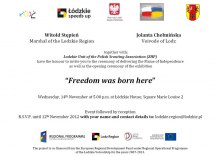
"Freedom was born here"
Date
Address
Event Type
Organiser type
Section
Event Location
Event Description
"Freedom was born here"
an event in the framework of the project "Łódzkie speeds up" under the auspices of His Excellency, Ambassador of the Republic of Poland to the Kingdom of Belgium and the Permanent Representative of the Republic of Poland to the European Union.
Evening agenda:
- Meeting of the Polish and Belgian Scouts by the monument "La naissance d'une nation» / Birth of a Nation, description in the attachment /; transferring the Flame of Independence,
- Speeches by the Governor and Marshal of the Łódzkie Region on the premises of Łódzkie House,
- Inauguration of the photography exhibition;
- Exchange of experiences between Polish and Belgian Scouts in maintaining historic heritage which constitutes a platform for shaping identity of free European nations,
- Screening of documentaries presenting historical events on the Eastern Front of the First World War,
- Concert: poetic songs performed by scouts,
- Tasting of the Volhynia (Ukrainian) specialties.
The memory of World War I teaches the future generations understanding of history and respect for the 10 million soldiers who died fighting in it. Every year we celebrate the anniversary of the armistice on the 11th of November 1918. On this day thousands of people pin a stamp in the shape of a poppy flower, symbolically called Remembrance Day Poppy. Ceremonies at the military cemeteries and battle sites usually take place in silence. Memory of the fallen – all the simple, ordinary people, caught up in the relentless vortex of war – is honored.
The names of Verdun, Ypres, Somme are well - known all around the world, but the fact that the future of Europe during World War I was being determined in the East, is known by very few Western Europe residents. Thousands of unknown soldiers were buried on forgotten war cemeteries, among them Poles. In 1914 more than 3.5 milion of them have been enlisted to the three occupying armies. They were not fighting for the Russian Tsar, the German Kaiser or the Austrian Emperor. They were fighting for Poland.
Nearly 500.000 soldiers were killed on the eastern front of the World War I. Their graves grew into the Polish landscapes of Mazury, Mazowsze, Podlasie, Lubelszczyźna, Podkarpacie, Małopolska, Świętokrzyskie Mountains and of the Łódzkie Land. In all those places remains of the battles were preserved : trenches, fortresses and various documents.
The event in the Łódzkie House constitutes the culmination of a series of actions undertaken in the recent years to commemorate those events and a real chance to remind the United Europe of the existence of the front on the Polish, Ukrainian, Lithuanian and Belarusian lands and of millions of people who died there. The subject of the World War I has already become a stimulus to tighten the relations between partner cities and regions, such as Łódź and Kaliningrad, Gusiewo and Pabianice, Koluszki and ... Verdun, where the activities undertaken in Poland were considered very successful. So it is on the initiative of Łódzkie that the project of international importance is being created.
In the thirties the European culture was marked by national and cultural awareness. « La naissance d’ une nation » (also called Geboorte Van een natie) is considered one of the symbols of this awareness.
The monument has been carved in the Carrara marble by a relatively unknown Belgian sculptor, Marius Vos. We do not know a lot about this author: he emigrated with his family to the United States and received American citizenship.
The statue was carved especially for the Paris exhibition in 1937, where it won a gold medal. In 1968 the artist donated it to the city of Brussels, where he was born. The City Council originally planned to plant the statue in the Heyzel Park. Ultimately, it was decided to place the statue where it stands now - in front of the Łódzkie House. An interesting fact connected with the monument is that the vegetation behind it helps to render less visible its back, which is considered unfinished.
Related Events
The Wilfried Martens Centre for European Studies in cooperation with the Ukrainian Think Tanks Liaison Office in Brussels are pleased to invite you to a discussion on the state of implementation of reforms in Ukraine in visa liberalisation and migration policy ar
DRAFT PROGRAMME
14:00 Registration: European Parliament Brussels, ASP Building, Entrance Esplanade, Place Luxembourg,
14:30 Welcome by Ms Silvana Koch-Mehrin, MEP ALDE INTA
ALDE Seminar
"EU-Russia trade - will the WTO change business?"
Wednesday 5 December 2012, 15:00 to 17:30
European Parliament (room ASP3G3)
9th INTERNATIONAL CONFERENCE ON
"THE EUROPEAN UNION, TURKEY AND THE KURDS"
THE KURDISH QUESTION IN TURKEY:?TIME TO RENEW THE DIALOGUE ?AND RESUME DIRECT NEGOTIATIONS
INTERNATIONAL PEACE INITIATIVE (IPI)
PRESS CONFERENCE
Monday 3rd December, 10h30, International Press Centre, Maelbeek Room
















